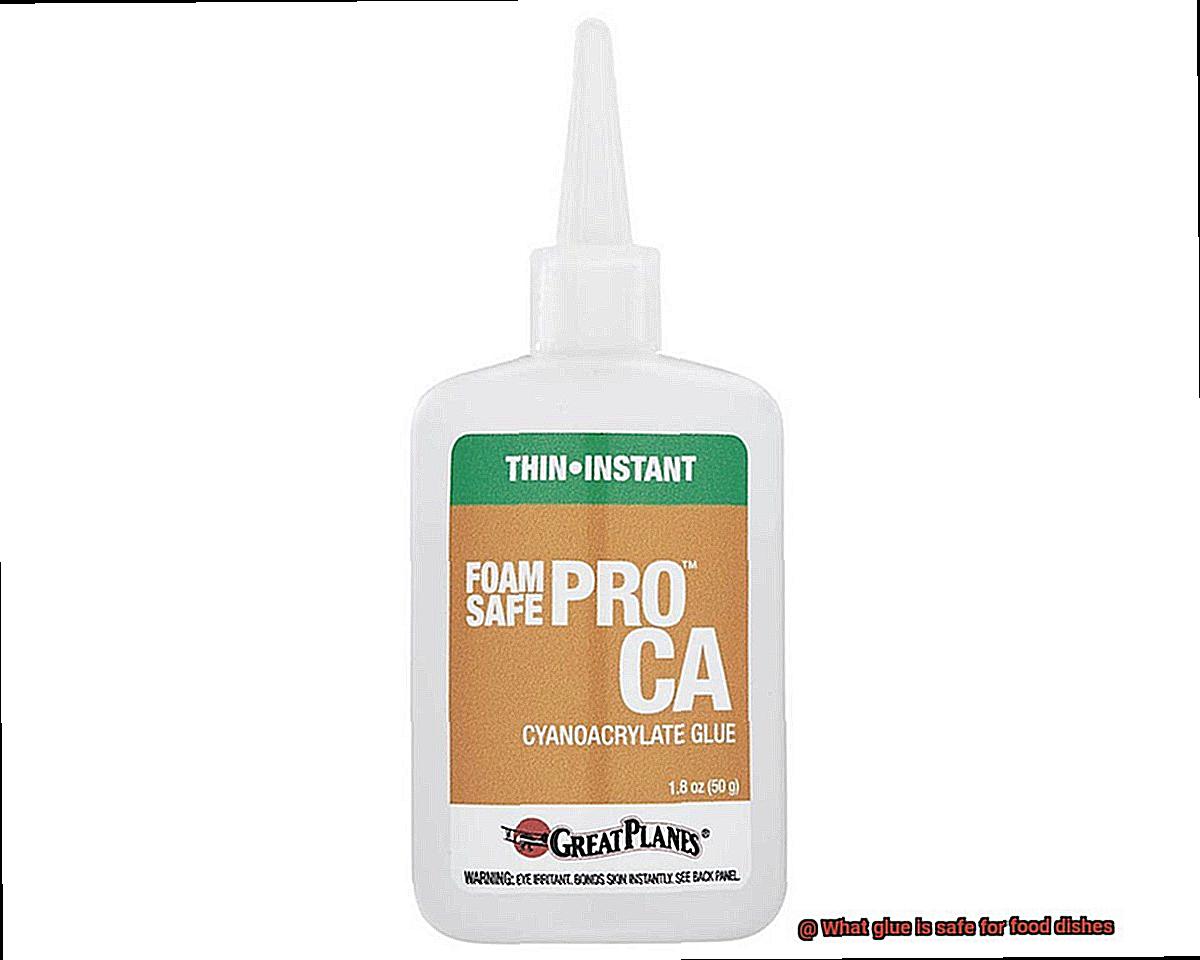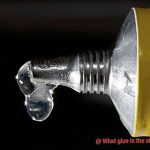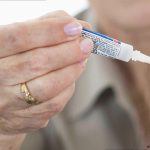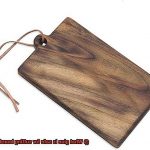Ever been in a sticky situation, desperately trying to mend your beloved food dish? We’ve all been there, my friend. But hold up before you grab any old glue from the depths of your toolbox. When it comes to food contact, safety is key. You don’t want any sneaky toxins or harmful substances creeping into your delicious creations.
So, let’s dive right into this blog post and uncover the lowdown on food-safe glues. From delicate ceramics and fragile glassware to trusty wooden utensils and reliable plastic containers, we’re about to explore a whole range of adhesives that’ll keep your repairs intact without compromising your well-being. Get ready to stick it together like a pro and ensure your culinary masterpieces stay flawless, free from any unwanted ingredients.
What Glue is Safe for Food Dishes?
Contents
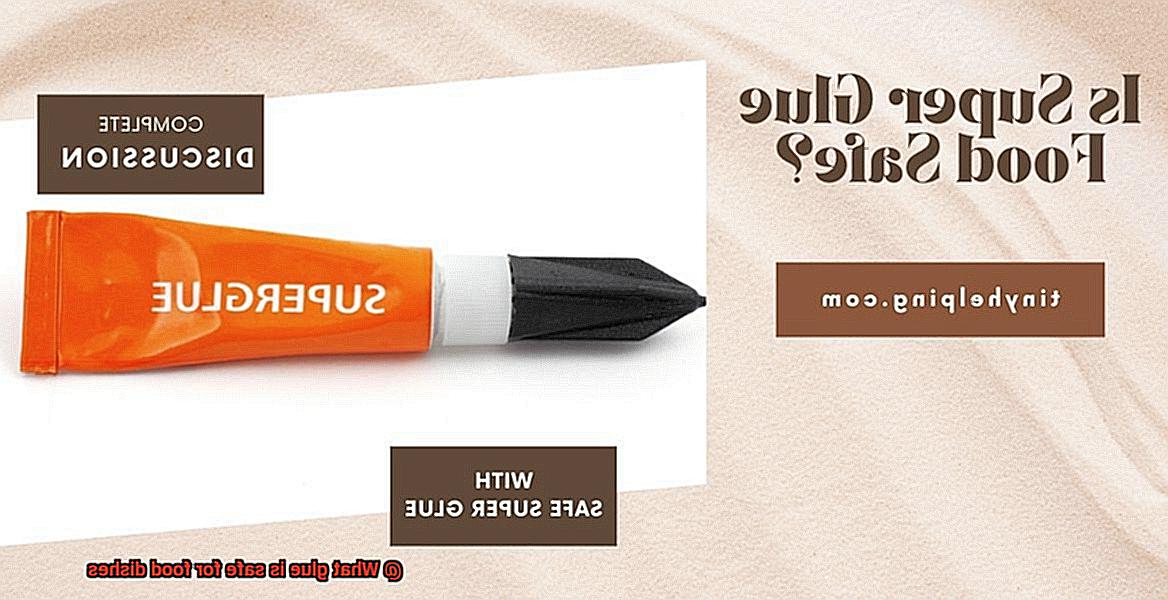
When it comes to repairing or attaching broken pieces of your cherished food dishes, prioritizing safety is paramount. Using the wrong adhesive can introduce harmful substances into your meals, posing potential health risks. This guide will explore various types of glue that are safe for food dishes, empowering you to make informed decisions and safeguard your kitchenware.
Epoxy Resin:
Epoxy resin stands as a popular choice for adhesion in food dishes. Its two-part formula, combining resin and hardener, creates a robust bond that resists moisture and heat. Once fully cured, epoxy resin is considered food-safe and suitable for repairing ceramic or glass dishes.
Silicone Adhesive:
Another safe option is silicone adhesive, renowned for its versatility. Withstanding high temperatures and exhibiting water resistance, it is ideal for dishwasher-safe kitchenware. Regulatory agencies have approved silicone adhesives for food contact, making them commonly used in kitchenware assembly.
Food-Grade Silicone Sealants:
Specifically designed to create a non-toxic and waterproof seal, food-grade silicone sealants excel at fixing cracks or leaks in food containers or lids. These sealants undergo FDA approval and effectively safeguard against potential contamination.
Food-Safe Cyanoacrylate Glue:
Food-safe cyanoacrylate glue, more commonly known as super glue, can also be utilized for repairing food dishes. Ensure that the chosen cyanoacrylate glue is labeled as food-safe since regular super glue releases toxic fumes when heated, making it unsuitable for food-related applications.
Ceramic Adhesive:
For ceramic or porcelain dishes, ceramic adhesive presents an excellent choice. Specifically designed to withstand high temperatures, these adhesives form strong bonds on ceramic surfaces. Look for non-toxic ceramic adhesives explicitly labeled as safe for use on food dishes.
Epoxy Resin
In this guide, we will explore the benefits and precautions of using epoxy resin in your kitchen, ensuring that your meals remain safe, stylish, and unforgettable.
Safety First:
When it comes to selecting an adhesive for your food dishes, safety should always be a top priority. Opt for epoxy resins that are labeled as food-safe or certified by regulatory authorities like the FDA or the European Food Safety Authority.
These resins are formulated with non-toxic materials and are free from harmful substances like BPA or phthalates. Rest assured that your food will remain pure and untainted, even after bonding with epoxy resin.
Advantages Galore:
Now, let’s dive into the remarkable advantages of using epoxy resin for your culinary creations. Firstly, its strong bonding properties ensure that your containers remain intact, sealing cracks and attaching handles with ease.
Say goodbye to leaks and spills during family gatherings or dinner parties.
But there’s more. Epoxy resin allows you to unleash your creativity and add a touch of elegance to your tableware. With endless possibilities for decorative designs or coatings on serving platters, bowls, and other dishes, you can turn ordinary kitchenware into stunning works of art. Want a burst of color?
Mix in some tint or experiment with glitter or metallic pigments for an extra “wow” factor. Your guests will be captivated by the beauty of your creations.
A Few Precautions:
Before you embark on your epoxy resin adventure, remember to follow the manufacturer’s instructions diligently. Mixing ratios and curing times are crucial to ensure a proper cure and avoid sticky areas that could contaminate your food.
Patience is key when working with epoxy resin – allow it to fully cure before using your food dish. This ensures that any residual odors or volatile compounds have dissipated, leaving your meals untainted and ready to be savored.
Conclusion:
With the right epoxy resin, you can infuse your food dishes with safety, durability, and a touch of elegance. Choose a food-safe option that meets regulatory standards, and let your creativity soar as you enhance your kitchenware’s aesthetics. Follow the instructions diligently and exercise patience during the curing process.
Cyanoacrylate Adhesive (Super Glue)
Today, we’ll be unraveling the mysteries of cyanoacrylate adhesive, commonly known as super glue. Prepare for a journey that delves into the properties and uses of this incredible adhesive, while uncovering the truth about its compatibility with food dishes. Let’s dive in.
Incredible Bonding Power:
Cyanoacrylate adhesive is renowned for its quick-drying and ultra-strong bonding capabilities. It works wonders on various materials, from metal to wood, creating a tight and long-lasting connection. Its ability to form an instant bond makes it a go-to choice for quick fixes and DIY projects.
Chemical Composition:

While super glue exhibits impressive fixing powers, it contains chemicals that may not be food-safe. These chemicals have the potential to leach into your food, compromising your health. It’s important to prioritize safety when it comes to matters of food consumption.
FDA Guidelines:
The Food and Drug Administration (FDA) is responsible for ensuring the safety of materials that come into contact with food. Unfortunately, super glue has not received their stamp of approval for food-related applications. The FDA establishes specific guidelines to protect consumers, and super glue simply doesn’t meet those standards.
Practical Considerations:
Beyond the potential health risks, using super glue on food dishes can lead to practical issues. Imagine painstakingly repairing your favorite ceramic plate, only to have it fall apart after a few washes. Super glue is not designed to withstand the heat and moisture associated with dishwashing, making it less-than-ideal for culinary applications.
Safer Alternatives:
There are safer alternatives available for repairing your cherished food dishes. Look for adhesives specifically labeled as “food-safe” or “food-grade.” These adhesives are formulated to be non-toxic and resistant to moisture and high temperatures. They’re like culinary superheroes, tailored to save the day.
Choosing the Perfect Match:
When selecting a food-safe adhesive, it’s crucial to read the labels carefully. Look for products that explicitly state their suitability for use on food-related items. Additionally, consider the material your food dish is made from. There are specialized adhesives for ceramics, glass, and plastic. It’s all about finding the perfect match for your culinary creations.
Conclusion:
While super glue may be a jack-of-all-trades in the adhesive world, it’s best to keep it away from your food dishes. Its chemical composition, lack of FDA approval, and practical limitations make it an unsuitable choice. Instead, opt for adhesives specifically formulated for food-related applications. Your taste buds and treasured dishware will thank you.
Silicone Adhesive or Sealant
When it comes to gluing or sealing your beloved food dishes, silicone adhesive or sealant is the ultimate champion, offering a plethora of benefits that will leave you feeling confident and secure. Let’s dive into the world of silicone and discover why it is the perfect choice for your culinary creations.
First and foremost, let’s talk about safety. Silicone is non-toxic, meaning that no harmful chemicals or substances will ever leach into your food. This is crucial when using adhesive on your dishes, as it will come into direct contact with your delectable delicacies. With silicone, you can have peace of mind knowing that your food remains pure and untainted.
But safety is just the beginning. Silicone adhesive is also a master of heat resistance. It can withstand temperatures ranging from -40°F to 500°F (-40°C to 260°C), making it an ideal companion for dishes that may be exposed to extreme heat during cooking or serving. No matter how fiery your kitchen gets, this adhesive will remain steadfast and effective.
Durability is another key advantage of silicone adhesive. It forms an unbreakable bond that will keep the repaired or attached parts of your dish securely in place. And not only that, but this remarkable adhesive also creates a flexible and waterproof seal, ensuring that no liquids leak or seep through. Say goodbye to messy spills and hello to dishes that maintain their integrity.
Now that we’ve covered the benefits, let’s talk about application. When selecting a silicone adhesive for your culinary adventures, be sure to choose a food-grade or food-safe product. These are specifically designed and tested to meet the necessary standards for use with food. Don’t settle for anything less than the best when it comes to your taste buds’ safety.
To achieve the perfect bond, it’s essential to prepare your surfaces properly. Clean and dry them thoroughly before applying the adhesive, removing any grease, oil, or residue that could hinder proper bonding. Once your surfaces are pristine, apply a thin and even layer of silicone adhesive to one side, then firmly press the pieces together. And remember, patience is a virtue – allow sufficient time for the adhesive to fully cure according to the manufacturer’s instructions before using your dish again.
Ceramic Adhesive
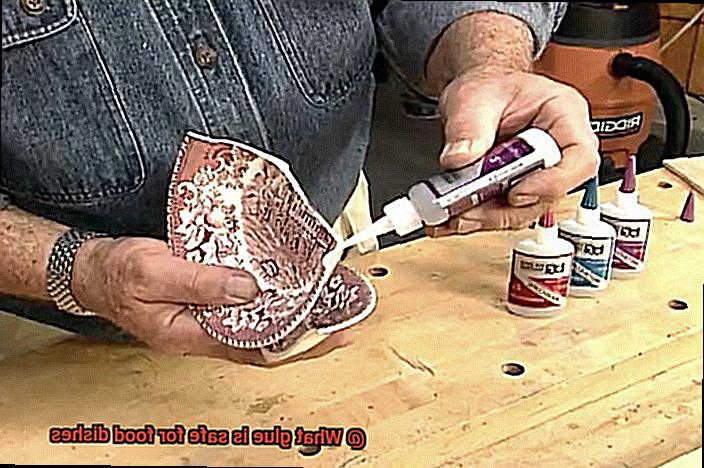
Imagine the heartbreak of seeing your favorite ceramic dish, passed down through generations, shattered into pieces. But fear not. With the right ceramic adhesive, you can bring it back to life. However, when it comes to repairing or bonding your precious food dishes, not just any adhesive will do. Safety is paramount, and selecting a safe and non-toxic ceramic adhesive is essential. Let’s explore the world of ceramic adhesives and why choosing the right one is crucial for your cherished food dishes.
The Importance of Safety:
When it comes to anything that comes into contact with our food, safety should always be our top priority. Using an adhesive that contains harmful chemicals or toxins can contaminate our meals and pose health risks. To ensure the safety of our loved ones, it is vital to opt for adhesives explicitly formulated for food contact.
Avoid These Types of Adhesives:
Not all adhesives are created equal, especially when it comes to food-related applications. Avoid adhesives lacking FDA approval or those containing solvents or volatile organic compounds (VOCs). These chemicals can seep into your food and wreak havoc on your health.
Consequences of Using Unsafe Adhesives:
Using an unsafe adhesive on your food dishes can have dire consequences. Apart from potential health risks, the adhesive may not withstand the heat of cooking or reheating. Picture serving a delicious casserole only to find out that the adhesive has melted and contaminated your dish. What a disaster.
Recommended Safe Adhesives:
Now that we understand the importance of safety, let’s delve into some recommended adhesive options that are safe for use on food dishes made from ceramic materials:
- Silicone Adhesive: This superhero adhesive is non-toxic and can withstand high temperatures. Look for food-grade silicone adhesives that are FDA compliant and specifically formulated for ceramic materials.
- Epoxy Resin: Choose an epoxy resin adhesive labeled as food-safe and free from harmful chemicals. Epoxy resin provides a strong bond and is often used for repairing ceramic dishes that come into contact with food.
- Cyanoacrylate (Super Glue): Opt for a cyanoacrylate adhesive labeled as food-safe and non-toxic. This adhesive forms a quick and durable bond, making it ideal for smaller repairs.
Other Considerations for Using Glue on Food Dishes
When it comes to repairing or reinforcing food dishes, using glue can be a convenient solution. However, before you reach for that bottle of adhesive, it is crucial to consider several important factors. In addition to selecting a safe and non-toxic glue, there are other key considerations that should not be overlooked. Let’s delve into the potential risks and benefits of using glue on food dishes, so you can make an informed decision and enjoy your meals worry-free.
Contamination Concerns:
The safety of your food should always be the top priority. To prevent any potential contamination, it is essential to ensure that the glue does not come into direct contact with the food. Apply the adhesive to areas of the dish that will not touch the food, such as the outer rim or underside. Furthermore, it is crucial to choose glues that are specifically labeled as safe for use with food. Look for adhesives that meet FDA regulations and have passed safety tests to avoid any harmful health effects.
Durability and Longevity:
Food dishes go through a lot of wear and tear, including exposure to varying temperatures and moisture. To ensure that your glued dishes remain intact over time, select a glue that can withstand these conditions. Consider the material of your dish – ceramic, glass, or plastic – and choose a glue suitable for that specific material. Opt for adhesives that offer a strong bond even in challenging environments, such as dishwasher-safe or waterproof glues.
Ease of Application and Cleanup:
Repairing your food dish shouldn’t be a complicated process. Choose glues that are easy to apply without requiring special tools or techniques. Look for options like squeeze tubes or applicators with precision tips for effortless application. Additionally, consider how easily the glue can be cleaned up if needed. Avoid glues that leave behind residue or require harsh chemicals for removal. Opt for glues that can be easily wiped or washed off without damaging the dish.
Dietary Restrictions and Allergies:
Food allergies and dietary restrictions are important factors to consider when using glue on food dishes. Carefully read product labels to check for any potential allergens or ingredients that may be unsuitable for specific dietary needs. Some glues may contain traces of common allergens like nuts or soy, so it is crucial to be diligent in your research. If you have any concerns, seek professional advice or consult with experts in the field.
Conclusion:
Proper Application and Curing Time for Food-Safe Glues
Look no further than food-safe glues. In this guide, we will delve into the proper application and curing time of these magical glues, ensuring that your creations are not only delicious but also safe to enjoy.
First things first – cleanliness is key. Before applying any glue, make sure your surfaces are squeaky clean. Grease, dirt, or moisture can sabotage the adhesive’s ability to create a robust and long-lasting bond. So grab that sponge and get scrubbing – your culinary masterpieces deserve a pristine canvas.
Next, let’s talk quantity. The right amount of glue is crucial for a successful bond. Too much glue can lead to excess seeping into your food (not the extra flavor we’re looking for), while too little may result in a weak bond. Follow the manufacturer’s instructions closely for that perfect balance – it’s an important recipe to follow.
Now, let’s get artistic with our application. To ensure even distribution, grab a small brush or applicator and spread that glue evenly over the surface. This way, no area gets missed or overlapped – perfection in every bond. Embrace your inner artist as you create a seamless connection between your ingredients.
Patience is a virtue in the world of food-safe glues. After applying the glue, give it ample time to cure. The curing time varies depending on the type of glue used, so don’t rush it. Follow the manufacturer’s guidelines for specific curing times – trust us, it’s worth the wait. Allow the glue to work its magic and form a strong and reliable bond.
During this curing process, treat your glued surfaces like prized treasures. Avoid excessive movement or stress because we want that adhesive to set properly and create an unbreakable bond. Keep an eye on temperature and humidity levels too, as they can influence the glue’s performance. Create a stable environment for your glue to thrive.
Finally, it’s inspection time. Once the curing time is up, gently tap or apply pressure on the bond line to test its strength. It should hold up like a champion – a testament to your careful application and patience. If any weak spots or imperfections are detected, don’t worry – just reapply the glue or seek professional advice. Your dedication to perfection will pay off.
23hOMH8hskk” >
Also Read: Is Elmer’s Glue Edible?
Conclusion
In conclusion, when it comes to fixing or bonding your food dishes, safety should always be your number one concern. Don’t take any risks with your meals – choose a glue that is specifically designed for food contact. There are plenty of options out there that have been rigorously tested and proven safe.
Epoxy resin is a fan favorite, known for its unbeatable strength and ability to withstand moisture and heat. If you need something that can handle high temperatures and create a watertight seal, silicone adhesive and sealants are the way to go. For smaller repairs, food-safe cyanoacrylate glue (aka super glue) is a reliable choice – just make sure it’s labeled as safe for food use. And if you’re dealing with ceramic or porcelain dishes, don’t forget about ceramic adhesive – it’s specially formulated to handle those materials and can handle the heat.
Remember, always read the labels carefully and look for products that explicitly state their suitability for use on food-related items. And don’t rush the process. Proper application and curing time are crucial for achieving a strong bond. So before you start gluing, give those surfaces a good clean, apply the adhesive evenly, and allow it plenty of time to cure according to the manufacturer’s instructions.
By following these guidelines and selecting the right glue, you can restore your cherished food dishes with confidence. No more worrying about potential health risks or unwanted ingredients sneaking into your meals.

